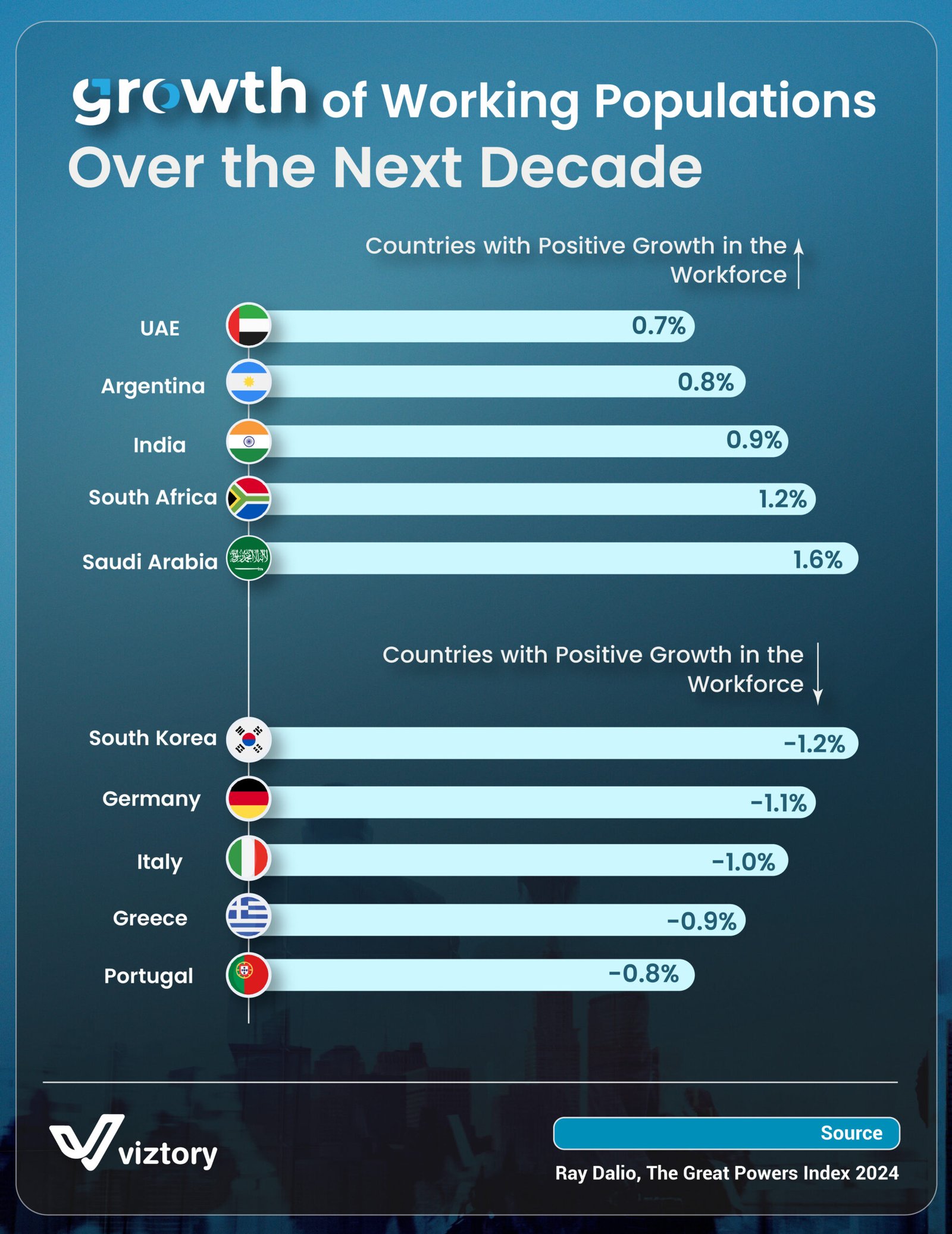Growth of Working Populations Over the Next Decade
-
Oct, Fri, 2024
Growth of Working Populations Over the Next Decade: Financial Implications for National Economies
The visualization highlights projected growth rates of working-age populations in various countries over the next decade, with Saudi Arabia leading at 1.6% and Portugal experiencing a decline of -0.8%. These demographic shifts carry significant financial implications, impacting everything from labor markets to economic growth and public spending. Understanding these trends is essential for policymakers and businesses as they adapt to the evolving workforce landscape.
Positive Workforce Growth and Economic Opportunities
Countries like Saudi Arabia (1.6%), South Africa (1.2%), and India (0.9%) are expected to see an increase in their working populations, which can translate into economic growth. A rising workforce means a larger tax base, increased consumer spending, and a potential boost in productivity. For these nations, leveraging the growing labor force through investments in education and job creation is essential for maximizing economic benefits. Additionally, a young and expanding workforce can attract foreign direct investment, as businesses seek markets with abundant labor and growth potential.
Financial Strains from Declining Workforces
In contrast, countries such as South Korea (-1.2%), Germany (-1.1%), and Italy (-1.0%) face declining working populations. A shrinking workforce can lead to labor shortages, higher wage demands, and increased dependency ratios, where fewer workers support a growing retiree population. This demographic trend can strain public finances as governments spend more on healthcare and pensions while receiving less in tax revenue. To mitigate these financial pressures, these countries may need to explore policies that encourage immigration, automation, and workforce participation among older citizens.
Labor Markets and Wage Dynamics
The growth or decline in working-age populations also affects labor markets and wage dynamics. In countries with workforce expansion, like the UAE (0.7%) and Argentina (0.8%), an influx of young workers can lead to competitive labor markets, potentially keeping wage inflation in check. Conversely, countries with a declining workforce may experience wage inflation as businesses compete for a smaller pool of qualified employees. This shift can drive up operating costs, impacting corporate profitability and potentially leading to higher consumer prices.
Impact on Global Investment Strategies
Demographic trends influence global investment strategies as investors seek markets with favorable growth prospects. Countries with positive workforce growth, like India and Saudi Arabia, may attract more capital as investors anticipate sustained economic expansion. On the other hand, economies with shrinking workforces, like Portugal (-0.8%) and Greece (-0.9%), might see reduced investor confidence, impacting currency strength and financial markets. Investors may prioritize sectors such as automation and healthcare in these countries, anticipating increased demand for solutions to address labor shortages and aging populations.
Conclusion
The projected shifts in working populations will shape the financial landscape for the next decade. Countries experiencing workforce growth have opportunities to harness economic gains, while those facing declines must navigate financial challenges associated with an aging population. By understanding these demographic changes, governments and businesses can make informed decisions to adapt and thrive, whether through investing in automation, encouraging workforce participation, or rethinking public spending priorities. Ultimately, demographic trends will continue to play a crucial role in determining the financial trajectories of national economies.

